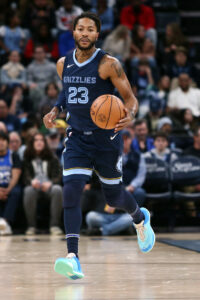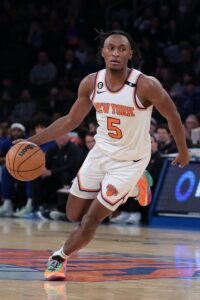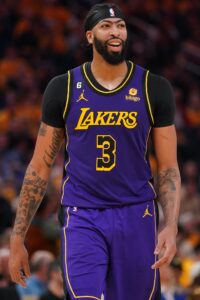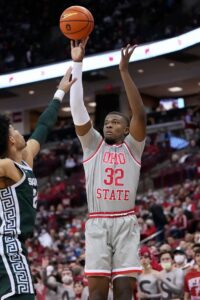If an NBA team’s salary continues to rise after it surpasses both the salary cap and the luxury tax line, it may reach or exceed a pair of tax “aprons.” The level of the first tax apron is several million dollars above the threshold at which a team becomes a taxpayer, while the second tax apron is another $10MM+ beyond the first apron.
A team whose salary exceeds the first apron is prohibited from making certain moves during that league year, while a team whose salary goes beyond the second apron faces even more restrictions. The goal is to limit the ability of the teams with the NBA’s highest payrolls to further upgrade their rosters and to encourage competitive balance.
Although the tax apron isn’t a new addition to the NBA’s Collective Bargaining Agreement, the 2023 CBA represents the first time that the league’s cap system features multiple aprons. The 2023 CBA also introduced several new rules that apply to teams whose salaries are above one or both aprons.
Let’s dive in and break down the tax aprons in greater detail…
How are the tax aprons calculated?
The formula that determined the level of the first tax apron in 2023/24 was as follows:
- Formula: $165,294,000 + ($6,716,000 x $129,838,000 / $123,655,000)
- Result: $172,346,000
- Note: The result was rounded to the nearest thousand.
These may just look on the surface like a collection of random numbers, but there’s a method to the madness. $165,294,000 is this season’s luxury tax line, while $6,716,000 was the gap between the tax line and the apron in 2022/23. $129,838,000 is the average of this season’s and last season’s salary caps, while $123,655,000 was the amount of last season’s salary cap.
More simply put: The gap between the tax level and the apron was calculated by taking last season’s gap and increasing it by a percentage representing half of this season’s cap increase. The cap rose by 10% this past summer; this year’s difference of $7,052,000 between the tax threshold and the first apron is 5% more than last year’s difference of $6,716,000.
Going forward, the first tax apron will increase at the same rate as the salary cap, making the calculation a little simpler. The formula will be as follows:
- $172,346,000 x (salary cap for that season / $136,021,000)
For instance, if the salary cap for 2024/25 comes in at $145,000,000, the first tax apron would be $183,723,000.
The calculation of the second tax apron, newly created for the 2023/24 season, was much more straightforward — it was simply a matter of adding $17.5MM to this season’s tax line, so the second apron came in at $182,794,000.
Like the first apron, the second apron will rise at the same rate of the cap in future seasons, meaning the formula will be as follows:
- $182,794,000 x (salary cap for that season / $136,021,000)
If we use that same example as above of a $145,000,000 cap for 2024/25, the second apron would come in at $194,861,000 next season.
What restrictions does a team face if its salary is above the first tax apron but below the second apron?
The restrictions facing teams above the first tax apron are different in 2023/24 than they will be in future seasons, since the NBA wanted to phase in those rules gradually rather than implementing them all at once. Rolling out the changes over a couple seasons gives teams the opportunity to adjust their rosters to account for the new apron-related rules.
Here are the moves that a team whose salary is above the first tax apron – but below the second apron – is prohibited from making in 2023/24:
- Acquiring a player via sign-and-trade.
- Using any portion of the bi-annual exception.
- Using more than the taxpayer portion (up to two years, with a starting salary of $5MM) of the mid-level exception.
- Signing a player who was waived during the current season if his pre-waiver salary for 2023/24 exceeded the amount of the non-taxpayer mid-level exception ($12,405,000).
- Taking back more than 110% of the salary it sends out in a trade (when over the cap).
The first four limitations on this list will remain in place in future seasons. The fifth will be modified to become even more restrictive.
Here are the additional moves that teams above the first apron – but below the second apron – will be ineligible to make beginning after the last day of the 2023/24 regular season:
- Taking back more than 100% of the salary it sends out in a trade (when over the cap).
- Using a traded player exception generated during the prior year (ie. between the end of the previous regular season and the end of the most recent regular season).
To clarify that second point, let’s say a team above the first apron currently has one trade exception worth $5MM, then generates another one worth $8MM at the 2024 trade deadline in February. Both of those exceptions would become unavailable once the team’s 2024 offseason begins.
That club could subsequently make a draft-night deal that generates a new $7MM TPE and use that exception at any point between its creation and the end of the 2024/25 regular season. But that TPE would once again become unavailable once the team’s 2025 offseason begins, prior to the typical one year expiration date.
What restrictions does a team face if its salary is above the second tax apron?
A team whose salary is above the second tax apron is prohibited from making any of the moves outlined above that are unavailable to teams above the first apron. That includes acquiring a player via sign-and-trade, using any portion of the bi-annual exception, and so on.
In 2023/24, a team above the second apron is also forbidden from using any portion of the mid-level exception.
Additional restrictions will be implemented beginning in 2024. Here are the moves that teams above the second tax apron won’t be permitted to make beginning after the last day of the 2023/24 regular season:
- Using any portion of the mid-level exception.
- Aggregating two or more player salaries in a trade.
- Sending out cash as part of a trade.
- Acquiring a player using a traded player exception if that TPE was created by sending out a player via sign-and-trade.
- Note: This includes taking back salary in the same transaction in which a player is sent out via sign-and-trade.
Teams above the second tax apron will face one more draft-related restriction beginning in the 2024/25 league year. If the team’s salary exceeds the second apron, its first-round pick in the draft seven years away will be frozen, making it ineligible to be traded.
If the team’s salary exceeds the second apron in at least two of the following four seasons (three of five in total), the frozen pick would move to the end of the first round for that draft. Conversely, if the team stays below the second apron for at least three of the subsequent four seasons, its pick becomes “unfrozen” and is once again tradable.
For instance, let’s say the Clippers finish the 2024/25 league year above the second tax apron. That would result in their 2032 first-round pick becoming frozen. If their team salary remains above the second apron for at least two more seasons between ’25/26 and ’28/29, their frozen pick would move to the end of the 2032 first round and would remain ineligible to be traded.
If multiple teams have a frozen pick moved to the end of the first round in a particular draft, they would make their selections in reverse order of their spot in the standings in the season prior to that draft. For example, if both the Clippers and Warriors have their 2032 first-rounders moved to the end of the round and Golden State finishes ahead of L.A. in 2031/32, the Clippers would pick ahead of the Warriors in that draft.
Can a team that begins a league year above the first or second tax apron gain the ability to make additional moves by reducing its salary and dipping below the apron(s)?
Yes. If a clubs opens the 2024/25 league year carrying $200MM in salary, then engages in a series of salary-dump trades that reduce its team salary to $125MM, it would no longer be subject to the restrictions facing a an apron team.
However, as long as the team’s salary remains above the first or second apron – or if the team is completing a transaction would push its salary above one apron or the other – that team is subject to the rules that apply to that apron level.
Critically, it’s worth noting that once a club engages in a roster move that is prohibited for a team above the first or second apron, that club will be hard-capped for the rest of the season at that apron level.
In 2023/24, for instance, teams like the Cavaliers and Rockets acquired players via sign-and-trade, the Lakers and Knicks used the non-taxpayer mid-level exception, and the Thunder and Trail Blazers took back more than 110% of their outgoing salary in trades. As a result, those teams are among several that are hard-capped at the first apron ($172,346,000) and aren’t permitted to surpass that salary level for the rest of ’23/24.
The Nuggets and Grizzlies are the only teams hard-capped at the second apron this season, since they used a piece of the mid-level exception that doesn’t exceed the taxpayer portion ($5MM) allotted to teams above the first apron.
Finally, there’s one more important point related to apron level restrictions and hard caps: A team that engages in any of the trade-related transactions prohibited for first or second apron teams between the end of the regular season and the end of that league year on June 30 will not be permitted to exceed that apron level during the following season.
If, for example, a team sends out cash in a trade in June of 2024, that team won’t be allowed to exceed the second tax apron during the 2024/25 league year. The inverse is also true — a team whose 2024/25 salary projects to be over the second apron won’t be able to trade cash in June.
This rule only applies to trade-related transactions because the ones related to free agency don’t come into effect between the end of the regular season and the start of the next league year.
Anything else I should know about the tax aprons?
It’s worth pointing out that a club with a number of incentive bonuses on its books may find itself operating above the first or second apron even if its base team salary doesn’t exceed those levels.
For the purposes of calculating a team’s salary, a player’s likely incentives are included in his cap hit, but his unlikely incentives aren’t (an incentive is considered likely to be earned if it was achieved last season and unlikely to be earned if it wasn’t). However, for the purposes of determining a team’s apron level, all those incentives are counted.
That means a team with a $170MM base salary in 2023/24 and an additional $5MM in unlikely incentives would be considered a first apron team and would be unable to make certain roster moves, since there’s a chance those incentives could be earned, pushing the club’s salary above $172,346,000.
Note: This is a Hoops Rumors Glossary entry. Our glossary posts will explain specific rules relating to trades, free agency, or other aspects of the NBA’s Collective Bargaining Agreement.
 The Rose rule allows a player who is finishing his rookie scale contract to sign a maximum-salary contract that exceeds the typical limit for a player with fewer than seven years of NBA experience. The rule, which was created after Rose won a Most Valuable Player award while playing on his rookie contract, allows young stars to qualify for a maximum salary worth 30% of the salary cap instead of 25%.
The Rose rule allows a player who is finishing his rookie scale contract to sign a maximum-salary contract that exceeds the typical limit for a player with fewer than seven years of NBA experience. The rule, which was created after Rose won a Most Valuable Player award while playing on his rookie contract, allows young stars to qualify for a maximum salary worth 30% of the salary cap instead of 25%. In recent years, the significant majority of rookie scale extensions that include Rose rule language have been more of a yes or no proposition — a player qualifies for the 30% max with an All-NBA spot, regardless of which team he makes.
In recent years, the significant majority of rookie scale extensions that include Rose rule language have been more of a yes or no proposition — a player qualifies for the 30% max with an All-NBA spot, regardless of which team he makes. Let’s use Knicks guard
Let’s use Knicks guard  The anniversary dates for signings have been complicated in recent years by the COVID-19 pandemic that forced the NBA to adjust its usual calendar during the 2019/20, ’20/21 and ’21/22 league years. For instance, the 2020 free agency period was delayed until November 21 instead of beginning on July 1.
The anniversary dates for signings have been complicated in recent years by the COVID-19 pandemic that forced the NBA to adjust its usual calendar during the 2019/20, ’20/21 and ’21/22 league years. For instance, the 2020 free agency period was delayed until November 21 instead of beginning on July 1.
 He has four years of NBA experience (ie. a player with five years of experience who missed two full seasons due to injuries would not be eligible).
He has four years of NBA experience (ie. a player with five years of experience who missed two full seasons due to injuries would not be eligible). A player on a two-way contract can be converted without his consent. In that scenario, he would receive the minimum salary for the remaining term of his contract. A player on a one-year two-way contract would get a one-year, minimum-salary standard contract, while a player with two years left on his two-way deal would get a two-year, minimum-salary standard contract.
A player on a two-way contract can be converted without his consent. In that scenario, he would receive the minimum salary for the remaining term of his contract. A player on a one-year two-way contract would get a one-year, minimum-salary standard contract, while a player with two years left on his two-way deal would get a two-year, minimum-salary standard contract.